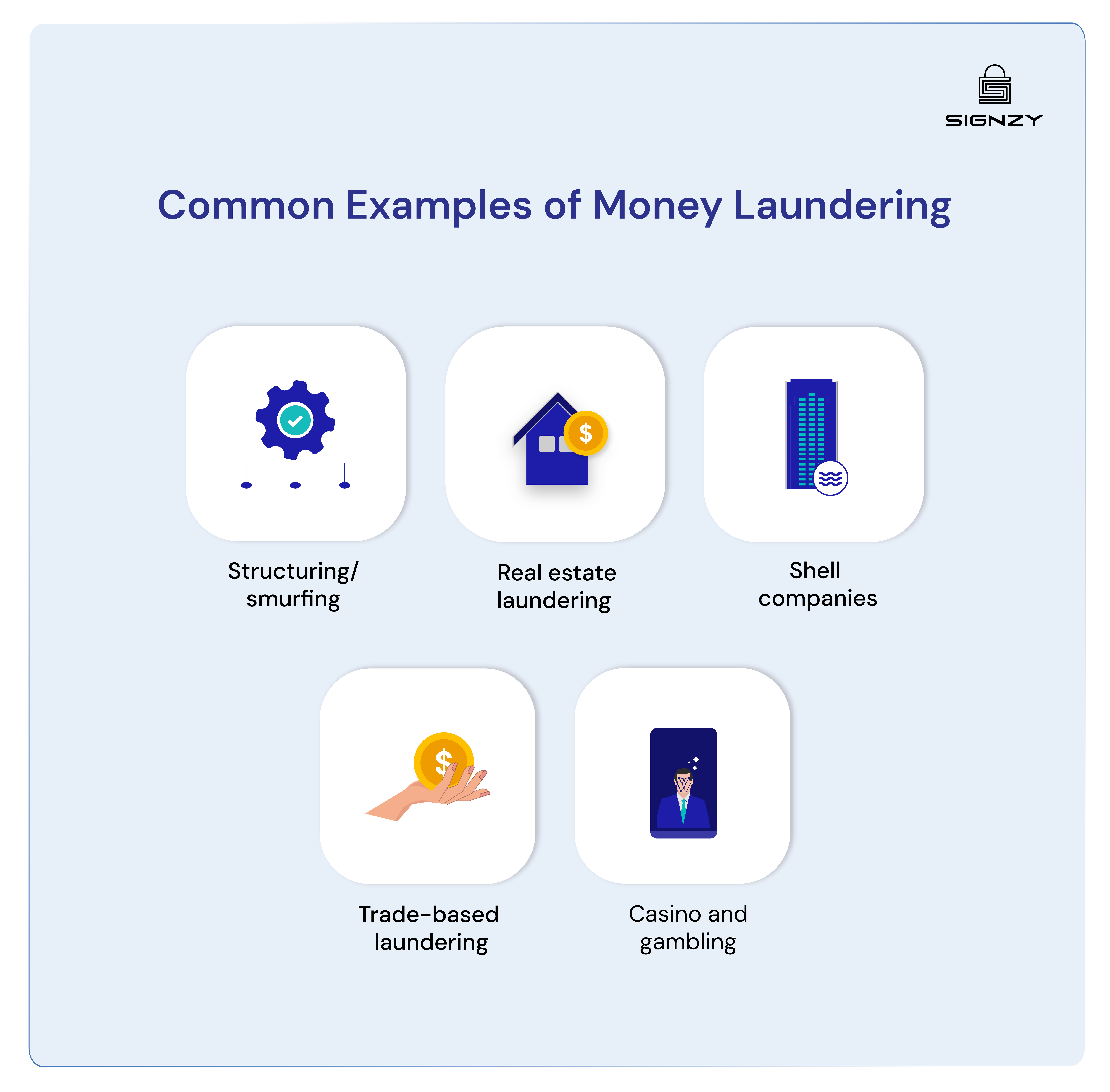Examples of Money Laundering
- Three Stages of Money Laundering: Money laundering typically involves three stages: placement, layering, and integration.
- Common Money Laundering Schemes: Structuring, real estate laundering, shell companies, and trade-based laundering are some of the most common methods used by criminals to launder money.
- Red Flags in Identifying Money Laundering: Complex corporate structures, unusual transaction histories, and frequent cash transactions are major red flags that may indicate money laundering activities.
- Impact on the Global Financial System: Money laundering fuels a wide range of criminal activities, including drug trafficking and terrorism, making it a serious global issue.
What is money laundering?
Money laundering is a process through which criminals try to conceal the illegal source of their funds. The funds, which are generally referred to as ‘black money’, get “cleaned” without attracting any legal consequences.
How?By passing it through complex transfers and a series of transactions involving multiple parties in between.
How does money laundering work?
Money laundering is a rather straightforward process. It works by locating a place to store the filthy money, using performative bookkeeping to make it appear as if the money came from legitimate transactions, and then returning clean money to the financial system. This includes three distinct steps.
Related Solutions
Three stages of money laundering
Money laundering consists of three stages: placement, layering, and integration.
Placement: Criminals identify a location to launder the money, which is frequently a business or another third party.
Layering: Criminals will then employ bookkeeping and other techniques to make the transaction appear genuine.
Integration: The criminal withdraws the clean money and deposits it in a financial institution, allowing them to spend it as they see fit.
What Are Some Common Examples of money laundering?
Money laundering takes many forms, including trading commodities, investing in assets, gambling, and counterfeiting.
Here are some common money laundering schemes, which include-

Structuring (also known as smurfing)
It involves breaking down large cash sums into smaller portions on purpose and depositing them into numerous accounts. This technique makes it challenging to detect illegal funds. In general, structuring seeks to evade financial restrictions demanding reporting big transactions, usually beyond a defined level, such as $10,000.
However, while criminals commonly utilize money orders and cashier’s checks for structuring, multiple deposits in these types in a short time might arouse suspicion at financial institutions, potentially triggering money-laundering investigations.
Real Estate Laundering
It is another popular type of money laundering in which criminals invest their illegal funds in the real estate sector while obscuring the source of their funds. Generally, organized crime groups launder money through real estate, successfully converting illegal funds into fixed assets (properties) that can be sold legally later.
This strategy entails using illegal funds to buy, sell, or lease real estate properties while giving the appearance of authorized financial activity.
Seeing this, many countries have begun to establish anti-money laundering legislation in real estate to fight this growing issue.
In February 2022, a private bank was accused of turning a blind eye to many unlawful real estate transactions, including permitting a Vatican-owned account to invest $350 million in a property in London. The Vatican lost millions of euros to mortgage brokers, including donations from the Catholic community.
Shell Companies
Shell companies and trusts are sophisticated structures commonly employed in money laundering activities. These companies, sometimes known as ghost firms, do not have actual ongoing business operations or significant assets.
Criminals frequently set up shell companies in offshore countries to conceal the true source of their money. When several shell companies are linked, the financial web’s intricacy rises, making it more difficult to track the money back to its origin.
In 2013, 1MDB, a Malaysian government-owned company, was accused of diverting $700 million into personal bank accounts of the then Prime Minister of Malaysia.
Trade-based Laundering
Trade-based laundering (TBL) is a money laundering technique in which criminals control the quantity and type of commodities exchanged in order to exchange stores over borders, while showing up to be lawful commerce exchanges. This method may involve over- or under-invoicing things, misrepresenting the quality or type of commodities, or falsifying documents such as customs declarations and invoices.
The complexity of TBL, combined with the complexity of international trade, makes it difficult for the authorities to detect and prevent this type of money laundering.
Casino and Gambling
Casinos and gaming pose an intriguing possibility for money laundering, with people using its busy atmosphere to disguise unlawful payments. Criminals take advantage of the fluidity and thrill of gambling, which allows them to masquerade their criminal riches as legal income.
These days, money laundering can take place in both conventional and internet casinos. Generally, a criminal uses illegal funds to buy casino chips or credits, loses and wins, and then withdraws. This technique effectively “cleanses” the money as it passes through the casino, producing a transaction history that appears to be authentic.
Another popular strategy is to bet large sums on low-risk games such as roulette or blackjack. These savvy gamblers may purposely lose some of their bets to make it appear like real gambling. They then exchange their chips for clean currency, which removes any doubt about the money’s origin.
How to Identify a money laundering Business or Individual?
Businesses must be alert in detecting symptoms of money laundering; it is not just sensible, but required under AML rules and regulations. Here are some of the major red signs that signal that more due diligence is required.
- Complicated corporate structures or the inability to identify the true owner of a company.
- Unusual transaction history, such as frequent high-volume transactions, brief stay periods in a bank account, or selling assets for less than market value.
- Purchasing objects having intangible values such as art, jewels, databases, software, and other assets.
- Unusual monetary losses that are not questioned by investors, such as continuing to invest in stock the following year after losing money the previous year.
- A large number of cash transactions, including paying employee salaries in cash.
But don’t worry, we have got your back. Signzy can help you detect these red flags during customer onboarding by assessing user documentation, biometrics, reliable data sources, and passive fraud signals.
💡 Related Blog:
How to prevent money laundering?
The best way to prevent money laundering is to implement anti-money laundering (AML) strategies. In the US, the Bank Secrecy Act forms the basis for AML Laws and Regulations. Let’s see what the Bank Secrecy Act says in this regard.
The Bank Secrecy Act mandates financial institutions, including broker-dealers, to create and implement anti-money laundering strategies. The Bank Secrecy Act and FINRA Rule 3310 require organisations, at a minimum, to:
- Formulate and implement policies and procedures in order to detect and provide immediate reporting of suspicious transactions.
- Formulate and execute policies, procedures, and internal controls to comply with anti-money laundering regulations.
- Provide for annual (calendar-year basis) independent compliance testing by internal members or a certified external party.
- Designate and identify to FINRA an individual or individuals in charge of carrying out and monitoring the organisation’s day-to-day operations and internal controls.
- Provide continuing training for employees and establish risk-based procedures for conducting ongoing customer due diligence.
Signzy’s can help you strengthen your AML screening and make your onboarding process more robust. Visit the website to learn more about how Signzy can help you.
FAQ
Is money laundering considered a serious crime?
Which agencies oversee money laundering in the United States?
Who is required to perform Anti Money Laundering checks?

Gaurav Gupta
Gaurav Gupta is the Global Product Head at Signzy, leading the strategy and development of the company’s KYC, KYB, AML, and digital onboarding products used by banks, fintechs, and financial institutions across global markets. He specializes in building scalable compliance and verification platforms, transforming complex regulatory and risk workflows into seamless, automated product experiences. Gaurav works at the intersection of product, engineering, and AI.









